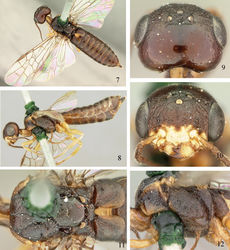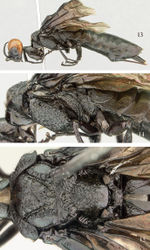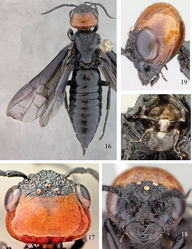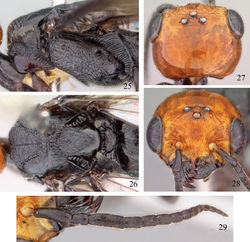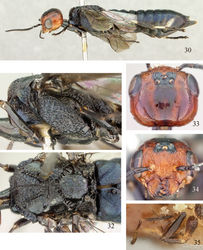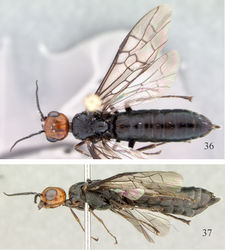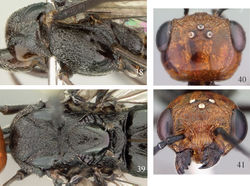Euxiphydria
| Notice: | This page is derived from the original publication listed below, whose author(s) should always be credited. Further contributors may edit and improve the content of this page and, consequently, need to be credited as well (see page history). Any assessment of factual correctness requires a careful review of the original article as well as of subsequent contributions.
If you are uncertain whether your planned contribution is correct or not, we suggest that you use the associated discussion page instead of editing the page directly. This page should be cited as follows (rationale):
Citation formats to copy and paste
BibTeX: @article{Smith2011JournalofHymenopteraResearch23, RIS/ Endnote: TY - JOUR Wikipedia/ Citizendium: <ref name="Smith2011Journal of Hymenoptera Research23">{{Citation See also the citation download page at the journal. |
Ordo: Hymenoptera
Familia: Xiphydriidae
Name
Euxiphydria Semenov & Gussakovskij – Wikispecies link – Pensoft Profile
- Euxiphydria Semenov & Gussakovskij, 1935: 117. Type species: Xiphydria potanini Jakovlev 1891[1], by original designation.
Diagnosis
Species are typically black with a contrastingly orange or mostly orange head (Figs 1, 13, 23, 30, 37). Antenna with 13–19 antennomeres, middle antennomeres dilated and compressed (Fig. 29). Head polished and shiny on upper genae and vertex to about level of lateral ocelli, variously sculptured on frons below lateral ocelli; in front view, inner margins of eyes parallel to slightly diverging below, lower interocular distance 1.4–1.7× eye height (Figs 4, 18, 28, 34, 41); head from above with distance behind eyes about equal to (Figs 3, 40) or longer than eye length (Figs 17, 27, 33); area posterior to upper orbits in profile usually longer than eye length; both mandibles 4-dentate; maxillary palpus (Figs 20, 35) slender, with four palpomeres; labial palpus (Figs 20, 35) with three palpomeres, first two palpomeres slender and third palpomere dilated, oval, with sensory pit. Forewing (Figs 1, 23, 36) with cell R closed, vein 2A+3A complete. Hind wing (Figs 1, 23, 36) with cell R closed, cells Rs and M present; anal cell present, petiole subequal to width of cell. Tarsal claws with long inner tooth near center of claw, about half length of outer tooth; claw of hind legs larger than those of fore- and midlegs. Tergite 10 posteriorly tubuliform, strongly protruding caudad.
Discussion
The above combination of characters will separate Euxiphydria from other xiphydriid genera. The only other genus with four maxillary palpomeres and three labial palpomeres is Carinoxiphia Wei (in Wei and Xiao 1999[2]). In Carinoxiphia, the third labial palpomere is slender, the same width as the first two palpomeres, the radial cell of the forewing is open at its apex, the tarsal claws have a minute inner tooth, and the wings are hyaline. Other xiphydriid genera have a different palpomere formula, commonly with three or five maxillary palpomeres, have a slender third labial palpomere, are usually black with various white, yellow, or orange markings, the eyes are larger, commonly converging with the lower interocular distance equal to or shorter than the eye height, the head behind the eye in dorsal view is commonly strongly narrowing with the distance behind the eyes shorter than the eye length, the antennae various but commonly filiform, and the tarsal claws may be simple or with the inner tooth nearly as long as the outer tooth and close to the outer tooth.
Four species were described prior to 1938, Xiphydria potanini Jakovlev, 1891, Xiphydria ruficeps Mocsáry, 1909, Xiphydria ruficeps Matsumura, 1912, and Xiphydria maidli Zirngiebl, 1937. When describing the genus, Semenov and Gussakovskij recognized and separated two species, Euxiphydria potanini and Euxiphydria ruficeps (= ruficeps Matsumura), and Gussakovskij (1935)[3] recognized and separated the same two species. Takeuchi (1938)[4] treated two species from Japan, Euxiphydria ruficeps ( = potanini, ruficeps Matsumura, akazui Matsumura, and maidli Zirngiebl) and Euxiphydria leucopoda, a second species described from Japan with a new form, which he called Euxiphydria leucopoda var. nakanishii. Maa (1944)[5] keyed four species, his newly described Euxiphydria atriceps and Euxiphydria subtrifida, as well as Euxiphydria potanini and Euxiphydria ruficeps. Later, Maa (1949)[6] transferred Euxiphydria leucopoda, Euxiphydria nakanshii, and Euxiphydria atriceps to Hyperxiphia Maa, and recognized Euxiphydria potanini, Euxiphydria ruficeps, Euxiphydria subtrifida, and Euxiphydria maidli. He also proposed a new subfamily, Euxiphydriinae, including only Euxiphydria. The only subsequent species described was Euxiphydria pseudoruficeps Okutani, 1966, from Taiwan. The catalogs by Smith (1978)[7] and Taeger et al. (2010)[8] have followed Takeuchi (1938)[4] and Stroganova (1968)[9] by regarding Euxiphydria potanini as a variable species and including Xiphydria ruficeps Mocsáry, Xiphydria ruficeps Matsumura, Xiphydria akazui, and Xiphydria maidli as synonyms, and listing two other species, Euxiphydria subtrifida Maa and Euxiphydria pseudoruficeps as distinct species. Here, we recognize five species, the more common Euxiphydria potanini with synonymy as given by Smith (1978)[7] and Taeger et al. (2010)[8], but also proposing Euxiphydria subtrifida as a new synonym, placing Euxiphydria leucopoda back into Euxiphydria, recognizing Euxiphydria pseudoruficeps as a distinct species, and describing two new species, one from China and one from Vietnam.
Taxon Treatment
- Smith, D; Shinohara, A; 2011: Review of the Asian wood-boring genus Euxiphydria (Hymenoptera, Symphyta, Xiphydriidae) of hymenoptera research/ Journal of Hymenoptera Research, 23: 1-22. doi
Other References
- ↑ Jakovlev A (1891) Diagnoses Tenthredinidarum novarum ex Rossia Europaea, Sibiria, Asia Media et confinium. Trudy Russkago Entomologitscheskago Obschtschestva v S. Peterburge 26: 1–62. (Separatum.)
- ↑ Wei M, Xiao W (1999) Three new genera and species of Xiphydriidae from south slope of Mt. Funiu (Hymenoptera: Siricomorpha), pp. 142–148. In: Shen X, Pei H (Eds.) Insects of the Mountains Funiu and Dabie Regions – The Fauna and Taxonomy of Insects in Henan, Vol. 4. China Agricultural Science and Technology Press. 415 pp. (In Chinese with English summary.)
- ↑ Gussakovskij V (1935) Insectes Hyménoptères, Chalastogastra 1. Fauna SSSR, Moskva, Leningrad 2(1). 453 pp.
- ↑ 4.0 4.1 Takeuchi K (1938) A systematic study on the suborder Symphyta (Hymenoptera) of the Japanese Empire (I). Tenthredo 2 (2): 173-229.
- ↑ Maa T (1944) Novelties of Chinese Hymenoptera Chalastogastra. Biological Bulletin of Fukien Christian Univeristy 4: 33-60.
- ↑ Maa T (1949) A synopsis of Asiatic Siricoidea with notes on certain exotic and fossil forms (Hymenoptera Symphyta). Musée Heude, Notes d’Entomologie Chinoise 8: 11-186.
- ↑ 7.0 7.1 Smith D (1978) Suborder Symphyta (Xyelidae, Parachexyelidae, Parapamphiliidae, Xyelydidae, Karatavitidae, Gigasiricidae, Sepulcidae, Pseudosiricidae, Anaxyelidae, Siricidae, Xiphydriidae, Paroryssidae, Xyelotomidae, Blasticotomidae, Pergidae). In van der Vecht J, Shenefelt RD (Eds.) Hymenopterorum Catalogus, pars 14, Dr. W. Junk B.V., The Hague. 193 pp.
- ↑ 8.0 8.1 Taeger A, Blank S, Liston A (2010) World catalog of Symphyta (Hymenoptera). Zootaxa 2580: 1-1064.
- ↑ Stroganova V (1968) [Horntails of Siberia.]. Nauka, Moscow. 147 pp. (In Russian.)
Images
|

